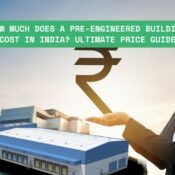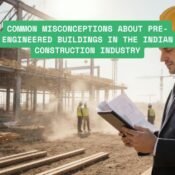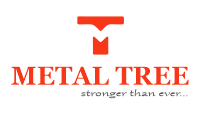
Pre-Engineered Metal Building Maintenance Tips: Essential Guide to Longevity & Cost Savings
Why Ignoring Maintenance Can Cost Businesses Millions
A well-known manufacturing business once expanded its operations by investing in a huge pre-designed metal building (PEB) for storage and production. Everything was strategic — it was cost-effective, quick to construct, and resulted in minimal downtime. Everything was perfect.
Fast forward five years, and the structure that used to stand as a mark of efficiency now had leaks, rust patches, and structural weaknesses. The primary assumption was that it was just wear and tear. However, an inspection revealed that the entire structure had been compromised due to lack of maintenance. The repairs and reinforcements alone cost lakhs, disrupting production, delaying shipments, and ultimately affecting revenue.
This is a scenario many businesses go through. Businesses invest in pre-engineered steel buildings because of their apparent durability but forget about regular maintenance. The truth is, even the best-built industrial sheds, factory sheds, and prefab warehouses require upkeep. Without regular maintenance, these mild issues have the potential to escalate into safety hazards, regulatory fines, or expensive repairs.
If you currently own or manage a PEB structure, this guide is for you. Let’s dive into maintenance tips that can enhance safety and extend the lifespan of the building.

1. Perform Inspections Regularly (At Least Biannually)
Would you drive a car for years without servicing it? Probably not. Set a maintenance schedule for your pre-engineered metal building as well. Inspections should occur at least twice a year, preferably before and after harsh weather seasons.
Key areas to inspect include:
✅ Roof & Gutters: Look for clogs, leaks, rusted guttering, dents, and other damage to water management systems. Even small leaks can compromise the building’s integrity.
✅ Walls & Panels: Check for loose fasteners, dented walls, or gaps that may cause air/water ingress.
✅ Foundation & Flooring: Monitor for cracks or shifts in concrete flooring, which can create structural gaps over time.
✅ Bolts & Fasteners: Ensure all screws, nuts, and bolts are tight. Loose fasteners weaken the foundation.
✅ Doors & Windows: Inspect seals and closures to prevent air leaks and ensure proper insulation.
2. Contain Rust & Corrosion Spread Before It Starts
Rusted parts on pre-engineered steel buildings can escalate into structural collapse if ignored.
How to prevent rust and corrosion:
🔹 Use protective coatings: Apply anti-rust coatings or galvanization to metal surfaces.
🔹 Fix leaks immediately: Water is the primary cause of corrosion.
🔹 Improve airflow: Reduce condensation buildup by ensuring proper ventilation.
🔹 Remove debris: Regularly clear leaves, dirt, or standing water from roofs to avoid rust spots.
3. Maintain the Roof to Avoid Costly Leaks
A tiny leak today can lead to a disaster tomorrow. PEB roofs endure relentless UV exposure, rain, and wind.
Best practices for roof maintenance:
🔸 Clear gutters and drainage channels to prevent standing water.
🔸 Repair or replace damaged roofing sheets immediately.
🔸 Inspect insulation layers for water absorption or wear.
🔸 Trim overhanging branches to avoid punctures during storms.

4. Keep the Building Clean to Prevent Structural Issues
Dirt, dust, and pollutants accelerate aging in metal buildings.
Cleaning tips:
🧼 Metal Panels: Wash with mild soap and a soft brush. Avoid bleach or harsh chemicals.
🧼 Windows & Skylights: Clean regularly to maximize natural light.
🧼 Floors: Remove industrial spills and moisture promptly. Apply protective sealants.
5. Maintain Insulation and Energy Efficiency
Poor insulation increases energy costs and reduces comfort.
Key steps:
🔹 Inspect insulation for tears, gaps, or mold.
🔹 Ensure HVAC vents are unblocked for optimal airflow.
🔹 Seal gaps around doors/windows to prevent air leaks.
6. Reinforce Structural Integrity
Strengthen your PEB to withstand extreme weather.
Tips to enhance durability:
✔️ Reinforce support columns: Ensure they bear vertical loads effectively.
✔️ Monitor foundation shifts: Small shifts can cause alignment issues.
✔️ Check earthquake resistance: Add braces in seismic zones.
✔️ Secure joints and bracing: Prepare for high winds or heavy rain.

7. Schedule Professional Maintenance Annually
While in-house checks are helpful, annual professional inspections are critical.
Benefits of professional inspections:
✅ Identify hidden issues early.
✅ Ensure compliance with safety regulations.
✅ Receive expert advice on upgrades.
✅ Boost resale value.
"At Metal Tree, we believe that a well-maintained pre-engineered metal building is more than just a structure-it's the foundation of operational efficiency and long-term success. Regular maintenance not only extends the lifespan of your investment but also ensures safety, energy efficiency, and cost savings. Because when you take care of your building, it takes care of your business."
Final Thoughts: Proactive Maintenance > Reactive Repairs
Pre-engineered metal buildings are cost-effective and durable, but they’re not invincible. Routine inspections, corrosion prevention, roof upkeep, insulation checks, and structural reinforcement are non-negotiable for longevity and safety.
Remember: Maintenance isn’t a cost - it’s an investment. A well-maintained PEB stays energy-efficient, safe, and financially sustainable.
When was the last time you assessed your pre-engineered metal building?
If you can’t remember, now’s the time to act!
🚀 Contact Metal Tree today for more Tips!
One thought on “Pre-Engineered Metal Building Maintenance Tips: Essential Guide to Longevity & Cost Savings”
Add a Comment Cancel reply
All Categories
Recent Posts
How Much Does a Pre-Engineered Building Cost in India? Ultimate Price Guide
Tags
Call Us at
+91 9311624628






[…] Addressing these concerns early on is key to improving PEB longevity. […]